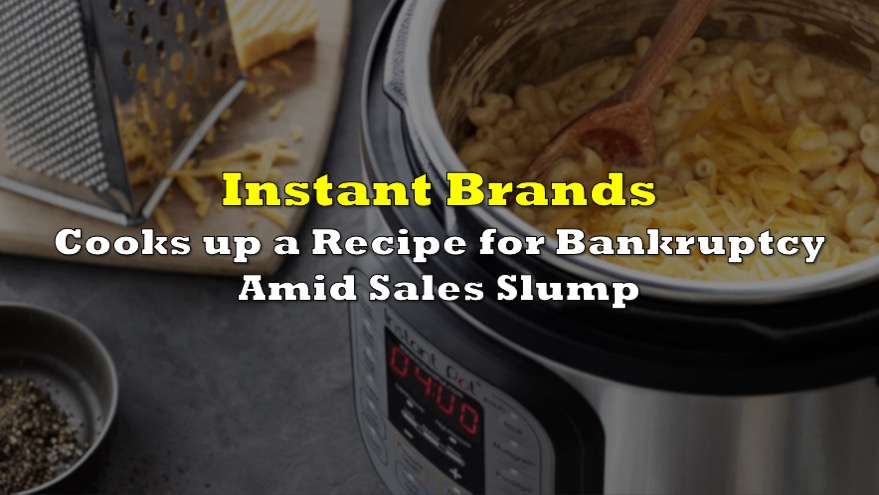The Instant Brands bankruptcy filing has received a lot more press attention than most bankruptcy filings.
People like those Instant Pots, and the popular collective conscience thinks they must sell a lot of them, because they work pretty good, everyone who has one wants to tell all their friends about it, would probably buy another one if it broke, etc.
Instant Brands’ creditors may have been thinking something similar when they extended $450 million worth of credit to the company in 2021. Presumably, they also had the benefit of being able to review Instant Brands’ financial statements to confirm this notion, and were satisfied that The Instant Pot Business was a good and solid business that would be able to pay them back, with interest.
This desk has not reviewed Instant Brands’ financial statements, which are not yet available. Ordinarily, they are due to be filed with the court 14 days after the bankruptcy petition is first filed, but Instant Brands has applied for (and been granted) relief that allows it to extend the deadline for filing schedules of assets and liabilities, income and expenditures, contracts and affairs, statements of financial affairs, and bankruptcy rule 2015.3 reports for an additional 45 days. The extension pushes the filing deadline to August 10th, 2023, but the debtors and their agents could always file for another extension, and there’s also a chance they wrap the whole thing up before the deadline comes; this filing gives every indication of a tight, organized, tactical operation.
Instant Brands also made a successful motion to redact the names of certain creditors, ostensibly for their personal privacy and safety. The Rule 2019 filing, where the creditors identify themselves to the court, shows $258 million in principal owed to entities being identified only by their agent firms.

The majority holder of Instant Brands’ shares when it did that borrowing was private equity firm Cornell Capital. Cornell remains the primary shareholder through this chapter 11 bankruptcy filing.
Traditionally, a chapter 11 filing protects a company from its creditors foreclosing on it, giving it a bit of breathing room to try and work out a deal with the creditors that keeps the company solvent. The company asks the court to approve a plan in which it remains in possession of its assets and continues to operate its business while it refines and executes a plan to re-structure its debt.
If the plan is approved by the company’s creditors, the debts and payment schedules are adjusted, and the business continues on under its new capital structure with revised debt obligations. If not, the business is dissolved, its assets are sold to pay off creditors, and Cornell Capital’s interest in the business no longer exists, because the business no longer exists.
To the creditors, a debtor-in-possession bankruptcy usually invites some salvage math: are they likely to get more out of their take from the proceeds of the company being sold off, in part or in whole, or from whatever the post-bankruptcy company is offering to pay them under the new debt structure?
A creditor that had secured its debt against the key capital assets of the business is in a better position to negotiate during a restructuring because, upon dissolution, the court is likely to grant a secured creditor title to those assets or proceeds from its sale.
It isn’t immediately clear what, if anything, the $390 million in debt Instant Brands was carrying at the time of its bankruptcy was secured against, but it does look like Cornell Capital knew what was important.
The Means of Production
The final bit of borrowing conducted by Instant Brands ahead of this filing was a $55 million asset-backed loan from cornerstone shareholder Cornell Capital itself. Understanding the transaction is kind of like trying to follow a description of a game of three card monte in Italian. It is explained in detail starting on page 20 of this declaration, but we’ve done our best to reduce the basics to plain English.
In January of 2022, Instant Brands put its New York and Pennsylvania factories into two unsecured subsidiaries (“the UnSubs”), who then leased those factories back to their parent company, Instant Brands. Goldman Sachs then wrote a $55 million letter of credit to the UnSubs, secured against their assets (the factories). In May of 2022, the UnSubs used their newfound liquidity to make a $55 million loan to Instant Brands.
The Goldman Sachs letter of credit to the UnSubs was then procured by Cornell Capital, making it the only secured creditor of the UnSubs, and the effective owner-by-proxy of the two factories, which are starting to look to us like the most important assets, by virtue of the fact that,
- a) Cornell made sure to get its arms around them before Instant Brands filed for bankruptcy, and
- b) manufacturing companies, by definition, need factories.
Other than its apparent inability to service its mountain of debt, this filing makes Instant Brands look like a business that has nothing wrong with it. Much of the petition has to do with securing the court’s permission for the company to operate its business exactly as it has been, using the staff it has now. It has applied for and been granted motions to use all of its bank accounts just as it has been, to keep its insurance paid up, keep its vendors paid, keep its employees paid, pay its payroll tax, pay the utility providers, etc.
The bankruptcy order specifically provides for the company to pay outstanding balances to any entity capable of putting a lien on equipment or property, so as not to have the lienors’ claim bog down the operations or the bankruptcy proceedings, which sounds kind of like a spousal protection order that provides for conjugal visits. Anyone wondering how they can afford to pay all of those bills might be interested to learn that, despite having just filed for chapter 11 bankruptcy protection, Instant Brands has exceptional credit.
“Float me a hundred and thirty mil or so? I just need it til this bankruptcy thing blows over.”
Cornell wouldn’t hold its lien on the factories for very long. A motion asking the court to approve post-petition financing in the amount of $132 million was filed the day after the initial petition, and approved the next day. The loan has been arranged through Jefferies Capital, by way of Guggenheim securities, thanks in part to Cornell’s having pledged the factories that it shielded in the subsidiaries by making them collateral against the new loan.
So here’s the timeline.
- 2017: Cornell Capital buys Instant Brands, rolls it up with Pyrex and Corning and various other cookware co’s.
- 2021: Instant Pot is making enough money that various lenders extend it $450 million in credit.
- May 2022: With $390 million of that credit outstanding, Cornell lends Instant Brands $55 million against its factory assets, ostensibly to service its debt.
- June 2023: Instant Pot files for Chapter 11 protection.
- June 2023: To keep the doors open through the storm, Instant Brands borrows $132 million against factory assets pledged by Cornell.
On the face of it, this looks like Cornell Capital preparing to wriggle out from under a net of $258 million in debt. Assuming a manufacturing company isn’t worth anything without its factories, the original creditors aren’t in a position to demand anything of value here, and are being surprisingly cool about it. One expects someone who is owed $390 million by a company whose shareholders just smuggled its core assets out of the company ahead of a bankruptcy filing to be screaming bloody murder, and asking the judge what kind of an operation he’s running here, but nobody’s said anything. The order to use the factories to backstop $132 million in post-petition financing was granted without creditor objection.
It’s a neat trick, and we’d be very interested in looking at financial statements that show the condition of this company in 2021 when un-identified entities loaned it somewhere between $258 and $450 million, and how those borrowings were allocated.
The breadcrumbs left for us in the filings so far show Instant Brands earning $57.23 million in 2022 EBITDA, and also show the company holding $157.8 million in consolidated net operating losses for the purpose of federal tax deduction, another $158 million in NOL available for state tax deductions, and approximately $81.4 million in interest expense deduction. Those bits of information are no replacement for financial statements, but they do make Instant Brands look like a cash-intensive manufacturing company that basically turns money over. Not the kind of thing a private equity company generally wants anything to do with, but Cornell seems to have made it work.
Since its 2017 investment in Instant Brands, Cornell has invested in various enterprises that we don’t know all that much about, accounting-wise. They’re all American companies that ship product, and sound like good businesses, but private equity is private, so there’s no way to tell.
The companies in Cornell’s portfolio do all sorts of different things. There’s a life insurance company, an IT talent firm, and companies that manufacture “highly engineered carrier tape and associated protective packaging products,” and “eyecare instrumentation,” and some kind of cable or something. Conventionally, a backer like Cornell would be betting that those companies’ operations are going to grow, and that the business will pay dividends, etc.
But fundamentally, business is about taking money out of someone else’s account, putting it in one’s own, and minimizing the cost of doing so to maximize the net proceeds. To the extent that Cornell’s portfolio companies are credit-worthy entities, each one can be jammed with some amount of debt to interest-thirsty creditors. In an environment where the operations can be protected, and bankruptcy courts sign off on pre-packaged deals that net five times that company’s annual earnings… why not do that instead? Fifty million dollars that a company earned selling widgets is taxable income. Two hundred and fifty million dollars worth of debt discharged through a bankruptcy is (generally) not.

The six billion in assets under management Cornell boasts today grew from $300 million or so in 2015. It’s unclear how much of that is new investment and how much is growth, but it’s something to be proud of either way.
For the lenders’ part, it might be that, when making the loans, they’re more interested in the near term bump to the assets side of their own balance sheets than the successful cash collection of the principal and interest. Indeed, a company that borrowed $258 million and paid it back in short order wouldn’t be of much use to a lender… It would just have to find another place to deploy the $258 million.
A company that drew $258 million out of a $450 million line, and let the interest spin the total up into the $390’s is less work, and makes for a higher number. Naturally, loans extended and extinguished as part of chapter 11 bankruptcies are considered investment losses for tax purposes, deductible against capital gains.
Information for this briefing was found via CNBC, Instant Brands, and the sources mentioned. The author has no securities or affiliations related to the organizations discussed. Not a recommendation to buy or sell. Always do additional research and consult a professional before purchasing a security. The author holds no licenses.





